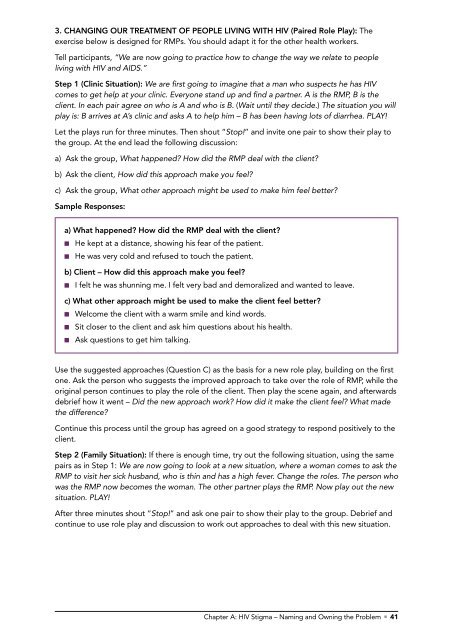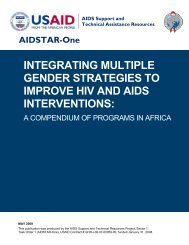HIV Stigma – Naming and Owning the Problem - ICRW
HIV Stigma – Naming and Owning the Problem - ICRW
HIV Stigma – Naming and Owning the Problem - ICRW
Create successful ePaper yourself
Turn your PDF publications into a flip-book with our unique Google optimized e-Paper software.
3. CHANGING OUR TREATMENT OF PEOPLE LIVING WITH <strong>HIV</strong> (Paired Role Play): The<br />
exercise below is designed for RMPs. You should adapt it for <strong>the</strong> o<strong>the</strong>r health workers.<br />
Tell participants, “We are now going to practice how to change <strong>the</strong> way we relate to people<br />
living with <strong>HIV</strong> <strong>and</strong> AIDS.”<br />
Step 1 (Clinic Situation): We are first going to imagine that a man who suspects he has <strong>HIV</strong><br />
comes to get help at your clinic. Everyone st<strong>and</strong> up <strong>and</strong> find a partner. A is <strong>the</strong> RMP, B is <strong>the</strong><br />
client. In each pair agree on who is A <strong>and</strong> who is B. (Wait until <strong>the</strong>y decide.) The situation you will<br />
play is: B arrives at A’s clinic <strong>and</strong> asks A to help him <strong>–</strong> B has been having lots of diarrhea. PLAY!<br />
Let <strong>the</strong> plays run for three minutes. Then shout “Stop!” <strong>and</strong> invite one pair to show <strong>the</strong>ir play to<br />
<strong>the</strong> group. At <strong>the</strong> end lead <strong>the</strong> following discussion:<br />
a) Ask <strong>the</strong> group, What happened? How did <strong>the</strong> RMP deal with <strong>the</strong> client?<br />
b) Ask <strong>the</strong> client, How did this approach make you feel?<br />
c) Ask <strong>the</strong> group, What o<strong>the</strong>r approach might be used to make him feel better?<br />
Sample Responses:<br />
a) What happened? How did <strong>the</strong> RMP deal with <strong>the</strong> client?<br />
■■<br />
■■<br />
He kept at a distance, showing his fear of <strong>the</strong> patient.<br />
He was very cold <strong>and</strong> refused to touch <strong>the</strong> patient.<br />
b) Client <strong>–</strong> How did this approach make you feel?<br />
■■<br />
I felt he was shunning me. I felt very bad <strong>and</strong> demoralized <strong>and</strong> wanted to leave.<br />
c) What o<strong>the</strong>r approach might be used to make <strong>the</strong> client feel better?<br />
■■<br />
■■<br />
■■<br />
Welcome <strong>the</strong> client with a warm smile <strong>and</strong> kind words.<br />
Sit closer to <strong>the</strong> client <strong>and</strong> ask him questions about his health.<br />
Ask questions to get him talking.<br />
Use <strong>the</strong> suggested approaches (Question C) as <strong>the</strong> basis for a new role play, building on <strong>the</strong> first<br />
one. Ask <strong>the</strong> person who suggests <strong>the</strong> improved approach to take over <strong>the</strong> role of RMP, while <strong>the</strong><br />
original person continues to play <strong>the</strong> role of <strong>the</strong> client. Then play <strong>the</strong> scene again, <strong>and</strong> afterwards<br />
debrief how it went <strong>–</strong> Did <strong>the</strong> new approach work? How did it make <strong>the</strong> client feel? What made<br />
<strong>the</strong> difference?<br />
Continue this process until <strong>the</strong> group has agreed on a good strategy to respond positively to <strong>the</strong><br />
client.<br />
Step 2 (Family Situation): If <strong>the</strong>re is enough time, try out <strong>the</strong> following situation, using <strong>the</strong> same<br />
pairs as in Step 1: We are now going to look at a new situation, where a woman comes to ask <strong>the</strong><br />
RMP to visit her sick husb<strong>and</strong>, who is thin <strong>and</strong> has a high fever. Change <strong>the</strong> roles. The person who<br />
was <strong>the</strong> RMP now becomes <strong>the</strong> woman. The o<strong>the</strong>r partner plays <strong>the</strong> RMP. Now play out <strong>the</strong> new<br />
situation. PLAY!<br />
After three minutes shout “Stop!” <strong>and</strong> ask one pair to show <strong>the</strong>ir play to <strong>the</strong> group. Debrief <strong>and</strong><br />
continue to use role play <strong>and</strong> discussion to work out approaches to deal with this new situation.<br />
Chapter A: <strong>HIV</strong> <strong>Stigma</strong> <strong>–</strong> <strong>Naming</strong> <strong>and</strong> <strong>Owning</strong> <strong>the</strong> <strong>Problem</strong> n 41
















